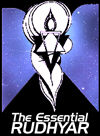 |
| Home | Bio | Art | Music | Literature | Civilization & Culture | Philosophy of Wholeness | Theosophy & Spirituality | Astrology |
 THE ESSENTIAL RUDHYAR
An outline and an evocation
by Leyla Raël 1983 I. FOUNDATIONS
II. CONCEPTUAL FORMULATIONS
1. The Experience of Change
2. Wholes in Time: Cycles 3. Wholes in Space: Entities 4. Wholeness 5. Holarchy & Dharma 6. Evolution & the Two-Way Cosmic Process 7. The Challenge of "Transfinite" Wholeness to Finite Wholes 8. Activity & Consciousness 9. The Principles of Unity & Multiplicity 10. The Movement of Wholeness 11. The Cycle of Being 12. Human Evolution & Reincarnation Within the Cycle of Being 13. The Constitution & Entire Cycle of Human Being 14. The Nature and Function of Mind 15. The Planetary Whole & the Place & Function of Human Evolution Within It 16. Rhythms of Culture & Civilization 17. The Process of Transformation 18. Transpersonal Activity 19. The Process of Deconditioning & Renewal
III. RUDHYAR'S
INTEGRATION OF EXPERIENCE AND CONCEPTS |

III. RUDHYAR'S INTEGRATION OF EXPERIENCE AND CONCEPTS
1. THE ARTS
Rudhyar's activities in the arts always have been a spontaneous, very personal — yet transpersonal — expression, unburdened by prolonged technical training or conditioning; and they unselfconsciously exemplify his philosophy and demonstrate his overall attitude to life.
For Rudhyar, art — its production and experience, has a different function at different stages of cultural development. The six levels of art-activity that follow can be adapted to apply to all the arts (poetry, literature, drama, music, painting, and sculpture) and correspond to stages in the development of a culture-whole:
1. Art as release of power through magical forms
Magical or so-called primitive art has as its aim the "purposeful release of focalized power through an effective form in answer to a need." Primitive art is essentially a means for magical action: magical objects are functional (intended to kill, tame, control, evoke animals or natural or elemental forces); they do not aim to be beautiful according to esthetic standards, for culture has not yet developed these.
2. Art as decorative enhancement of value
Not essentially different from magical, but meant to display the skill of the maker and/or the wealth and taste of the owner; bridge between purely magical-functional art and esthetic art.
3. Art as esthetic enjoyment of cultural forms
Art expressing the classical period of a culture; appreciated according to culturally-defined esthetic values, the main function of which is to reveal the principles of order and proportion that give members of the culture a sense of peace, security, or exaltation. Eventually leads to "art for art's sake."
4. Art as personal expression
The art of a culture's romantic period; art as autobiography expressing and glorifying the sufferings and, more rarely, the triumphs of the individual. Romanticism leads to Expressionism, surrealism, and the many varieties of avant-garde art, the main function of which is to decondition the consciousness of both artists and art lovers from conditioned cultural values and taboos.
5. Art as catharsis and mantram of rebirth
The art of a culture in crisis; artists act as agents for catabolic action, eventually destroying what is left of the disintegrating collective psychism. Eventually leads to reactionary movements — neoprimitivism, neoscholasticism, neoclassicism.
6. Art as [transpersonal] Hierophany
Art as a transcultural factor (working through culture but not of culture) . This type of art could be called "transcrete" art – that is, meaning "grows through" or is revealed through its forms. Rudhyar also calls it mythopoetic seed art, which projects into the planetary psyche new images to galvanize a new consciousness and new culture.
By permission of Leyla Rudhyar Hill Copyright © 1983 by Leyla Raël All Rights Reserved.  Web design and all data, text and graphics appearing on this site are protected by US and International Copyright and are not to be reproduced, distributed, circulated, offered for sale, or given away, in any form, by any means, electronic or conventional. See Notices for full copyright statement and conditions of use. Web design copyright © 2000-2004 by Michael R. Meyer. All Rights Reserved. |
 |